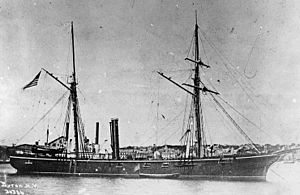USS Marblehead (1861) facts for kids

USS Marblehead
|
|
Quick facts for kids History |
|
|---|---|
| Name | USS Marblehead |
| Builder | George W. Jackman Jr., Newburyport, Massachusetts |
| Launched | 16 October 1861 |
| Commissioned | 8 March 1862 |
| Decommissioned | 4 September 1868 |
| Fate | Sold, 30 September 1868 |
| General characteristics | |
| Class and type | Unadilla-class gunboat |
| Displacement | 691 tons |
| Tons burthen | 507 |
| Length | 158 ft (48 m) (waterline) |
| Beam | 28 ft (8.5 m) |
| Draft | 9 ft 6 in (2.90 m) (max.) |
| Depth of hold | 12 ft (3.7 m) |
| Propulsion | 2 × 200 IHP 30-in bore by 18 in stroke horizontal back-acting engines; single screw |
| Sail plan | Two-masted schooner |
| Speed | 10 kn (11.5 mph) |
| Complement | 114 |
| Armament |
|
The USS Marblehead was a special type of small warship called a gunboat. It was built for the United States Navy during the American Civil War. Launched in October 1861, the Marblehead began its service in March 1862. Its first commander was Lieutenant Commander Somerville Nicholson.
Contents
Serving in the Civil War
The Marblehead first joined the North Atlantic Blockading Squadron. This group of ships helped block Southern ports during the war. The Marblehead took part in actions along the York and Pamunkey Rivers in Virginia.
Supporting the Peninsula Campaign
On May 1, 1862, the Marblehead helped shell Confederate positions. This was near Yorktown, supporting General George B. McClellan's plan to move his army toward Richmond. This plan was known as the Peninsula Campaign.
Facing Cavalry on the Pamunkey River
In an unusual fight, the Marblehead was docked on the Pamunkey River. A Confederate cavalry leader, J. E. B. Stuart, ordered his soldiers to attack the ship. Union sailors and marines on board saw them and started firing.
Confederate horse artillery, led by Major John Pelham, quickly set up their cannons and fired at the Marblehead. As the ship started to move away, the Union soldiers got back on board. Pelham's cannons kept firing, chasing the ship as long as the horses could keep up. The Marblehead managed to escape this attack.
Patrolling the Southern Coast
After this, the Marblehead was sent to the South Atlantic Blockading Squadron. It began patrolling off the southern East Coast, looking for Confederate ships. In February 1863, it worked with another warship, the Passaic. They explored the Wilmington River in Georgia. They were trying to find a powerful Confederate ironclad ship called the CSS Atlanta, but they did not find it.
Later that month, on February 23, the Marblehead took control of a captured ship called the Glide. This ship was carrying a valuable cargo of cotton. It had been captured by other Union ships near Tybee Creek, Georgia, while on its way to Nassau.
Battles on the Stono River
While patrolling coastal rivers, the Marblehead often helped out on the Stono River in South Carolina. It supported Union soldiers defending James Island. On July 16, 1863, Confederate forces attacked this position. The gunboat came under fire from Southern cannons at Grimball's Landing.
Even though it was forced to move further down the river, the Marblehead kept firing its guns. This helped prevent Confederate reinforcements from reaching their main attack force. After this, it joined in bombing forts in Charleston, South Carolina harbor. Then, it headed north for repairs.
By November, the Marblehead was back on the Stono River with another ship, the Pawnee. They helped protect Army troops who were sinking large poles in the river. These poles were meant to block enemy ships above Legareville, South Carolina.
The next month, on Christmas Day, Confederate cannons opened fire on the two gunboats. They wanted to stop the support the Marblehead and Pawnee were providing. The Marblehead was hit 20 times. However, it managed to capture two of the enemy's large cannons before returning north for more repairs and new duties.
Four of its sailors received the Medal of Honor for their bravery during this fight. These heroes were Contraband Robert Blake, Boatswain's Mate William Farley, Quartermaster James Miller, and Landsman Charles Moore.
Later Service and Decommissioning
On June 2, 1864, the Marblehead was ordered to serve as a training ship. It helped Naval Academy students, called midshipmen, practice at Newport, Rhode Island. A month later, this training was paused as the ship went back to coastal patrol duties for five months.
After that, it returned to Newport to continue as a practice ship. Once this duty was finished, the Marblehead arrived at the Washington Navy Yard. It was officially taken out of service, or decommissioned, on September 19, 1866.
However, it was put back into service the next month. It joined the North Atlantic Squadron and operated in the Caribbean for the next two years. On August 18, 1868, the ship returned to the New York Navy Yard. It was decommissioned again on September 4 and was sold on September 30, 1868.


